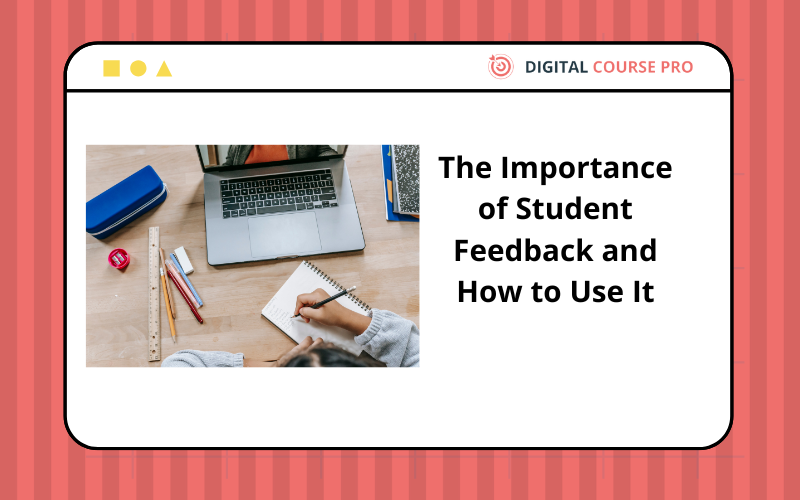The Importance of Student Feedback and How to Use It cannot be overstated in the realm of online education. For course creators, understanding what students think and feel about their courses is invaluable. Student feedback offers insights into what works well and what needs improvement, helping you refine your courses and enhance the learning experience. In this blog post, we will delve into seven essential tips on how to effectively collect and use student feedback to elevate your online course offerings.
1. Establish Clear Feedback Channels
Creating clear and accessible feedback channels is the first step in leveraging student feedback. This might include surveys, suggestion boxes, discussion forums, and direct email communication. Ensure that these channels are easy to find and use. Regularly encourage students to share their thoughts and make it clear that their feedback is valued and will be acted upon.
2. Use Structured and Unstructured Feedback
Both structured and unstructured feedback provide valuable insights. Structured feedback can be collected through standardized surveys with specific questions, while unstructured feedback might come from open-ended questions or casual comments in discussion forums. The combination of these feedback types offers a comprehensive view of student experiences and opinions.
3. Analyze Feedback Regularly
Regular analysis of student feedback is crucial. Set a schedule for reviewing feedback, whether it’s weekly, monthly, or at the end of each course module. Look for recurring themes and issues that students mention. Use data analytics tools to help quantify and visualize feedback trends, making it easier to identify areas for improvement.
4. Act on Feedback Promptly
Timely action on feedback shows students that their opinions matter and fosters a positive learning environment. When students see that their suggestions lead to real changes, they are more likely to continue providing valuable feedback. Address common concerns swiftly and communicate any changes made as a result of student feedback.
5. Incorporate Feedback into Course Design
Integrate student feedback into your course design and development process. Use the insights gained to tweak content, improve instructional methods, and enhance user experience. For example, if multiple students find a particular module confusing, consider revising the material or adding additional resources to clarify key points.
6. Create a Feedback Loop
Establish a feedback loop where students are informed about how their feedback has been used to make improvements. This can be done through announcements, newsletters, or discussion posts. A feedback loop not only keeps students engaged but also demonstrates your commitment to continuous improvement and responsiveness.
7. Encourage Constructive Feedback
Encourage students to provide constructive feedback by framing questions in a way that elicits detailed and actionable responses. Instead of asking “Did you like the course?”, ask “What specific aspects of the course did you find most valuable and why?” This approach helps gather more precise and useful feedback that can lead to meaningful improvements.
Conclusion
The Importance of Student Feedback and How to Use It is a fundamental aspect of developing and refining online courses. By establishing clear feedback channels, utilizing both structured and unstructured feedback, and analyzing this data regularly, course creators can gain deep insights into their students’ experiences. Acting promptly on feedback and integrating it into course design ensures that your courses remain relevant, engaging, and effective.
Creating a feedback loop where students are informed about the impact of their suggestions fosters a positive and collaborative learning environment. Encouraging constructive feedback and framing questions to elicit detailed responses further enhances the value of the feedback you receive.
Effective use of student feedback can transform your courses, making them more aligned with student needs and expectations. The Importance of Student Feedback and How to Use It lies in its ability to guide continuous improvement, helping you stay ahead in the competitive e-learning market.
Remember, student feedback is an ongoing process. Regularly revisiting and updating your feedback strategies ensures that you remain responsive to the evolving needs of your learners. By valuing and acting on student feedback, you not only improve the quality of your courses but also build a strong, engaged community of learners who feel heard and appreciated.
In conclusion, embracing The Importance of Student Feedback and How to Use It is essential for any course creator aiming for excellence. By diligently collecting, analyzing, and acting on feedback, you can create a dynamic and responsive learning environment that continuously evolves to meet the needs of your students. This commitment to improvement not only enhances student satisfaction but also solidifies your reputation as a forward-thinking and student-centered educator.
If you’re ready to transform your online course business into a profitable venture, be sure to check out our comprehensive guide on How to Make $10,000 a Month with an Online Course Business. Packed with practical strategies, expert tips, and actionable advice, this blog post will help you turn your passion into a steady income stream. Whether you’re just starting out or looking to expand your current courses, our guide provides the essential tools and insights to achieve your financial goals. Visit our blog now and start your journey to making $10,000 a month!





